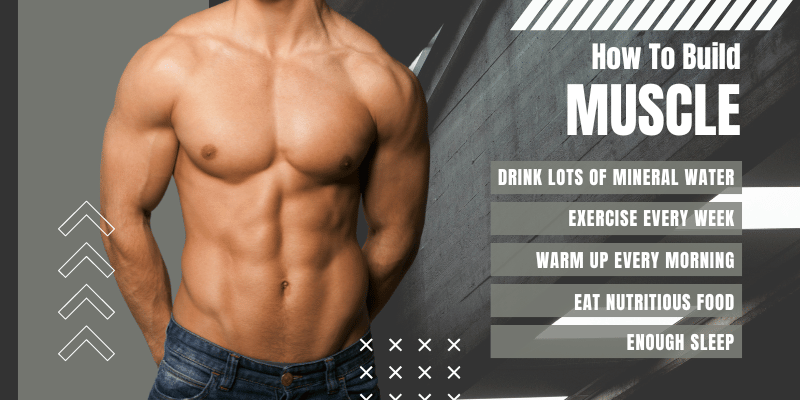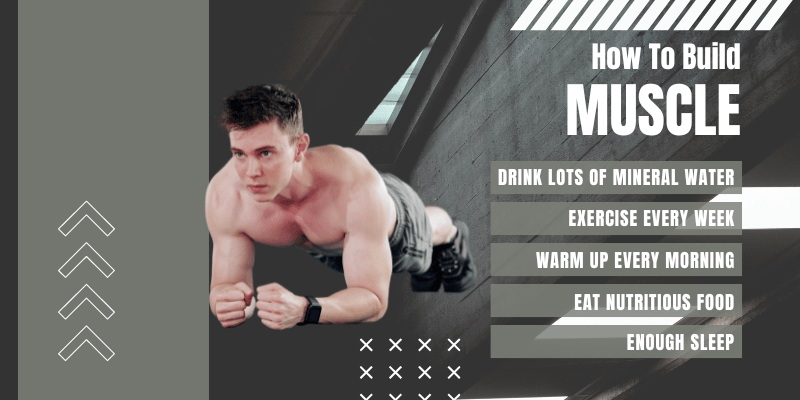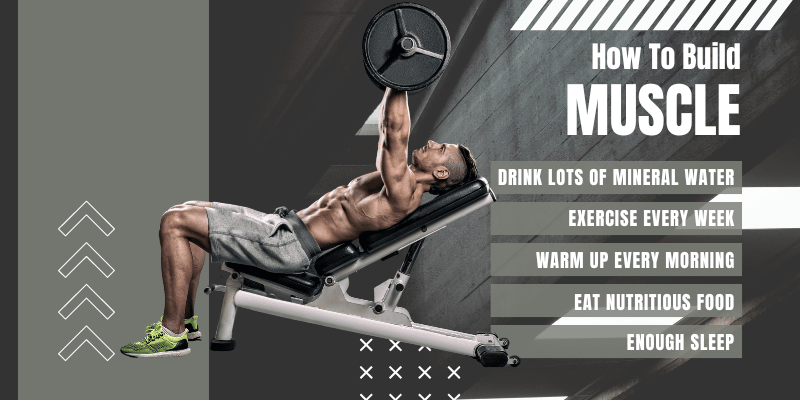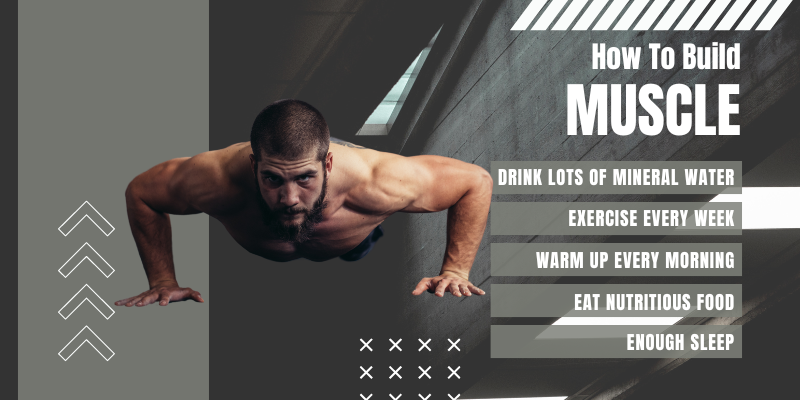Build Muscle the Wellhealth Way: Your Practical Guide to Gains
By S Sut - Updated On 03-04-2024

Sculpted muscles are not just about aesthetics. A strong, well-developed physique translates to a healthier you. Increased muscle mass strengthens your bones, improves metabolism, boosts confidence, and even helps with everyday activities. But for many of us, the path to building muscle can feel like a winding road with no clear map.
Fear not, fellow fitness adventurer! This guide will equip you with the knowledge and practical steps to embark on your muscle-building journey. We'll ditch the generic routines and focus on clear, actionable strategies you can implement right away.
Table of Contents
The Wellhealth "How to Build Muscle" Tag emphasizes a comprehensive approach to muscle building. This includes strategic workouts, a balanced diet rich in protein and complex carbs, and prioritizing recovery through sleep and active rest days. Wellhealth focuses on building muscle alongside overall health and well-being.
Why Lift Weights? The Science Behind the Gains
Our muscles are made up of tiny fibers that contract to generate force. Strength training, also known as resistance training, works by stressing these fibers. This controlled damage triggers a repair process, and voila – your muscles grow back stronger! This adaptation, called muscle hypertrophy, is what we're aiming for.

But it's not just about the weight. To maximize muscle growth, we need to consider two key factors: progressive overload and muscle confusion.
- Progressive overload simply means gradually increasing the challenge on your muscles. This can be done by lifting heavier weights, increasing the number of reps or sets, or decreasing rest time between sets. As your muscles get stronger, you need to keep pushing them to continue growing.
- Muscle confusion prevents your body from adapting too much to a specific routine. This doesn't mean throwing random exercises together. Instead, focus on targeting different muscle groups and varying your exercises within those groups.
Building Blocks for Success: Food and Recovery
Think of your body as a construction zone. To build muscle, you need the right materials (food) and sufficient rest for repair (recovery). Let's break it down:
- Protein is King: Protein provides the building blocks for muscle tissue. Aim to take 0.8 to 1 gram of protein per pound of body weight daily. This can come from lean meats, fish, eggs, dairy, and plant-based sources like beans, lentils, and tofu.
- Don't Ditch Carbs: Carbs provide energy for your workouts and replenish glycogen stores in your muscles. Choose complex carbs like vegetables, whole grains, and fruits for sustained energy.
- Healthy Fats are Friends: Don't fear fats! They play a crucial role in hormone production and nutrient absorption. Opt for healthy fats like nuts, avocado, seeds, fatty fish and red meat.
- Hydration Hero: Water is essential for all bodily functions, including muscle recovery. Aim for at least eight glasses of water daily, and adjust based on your activity level.
Rest and Recharge: Give Your Muscles Time to Grow
Aim for 7-8 hours of quality sleep each night. Your body repairs tissues and releases growth hormone, crucial for muscle development during sleep. Light activities like walking, yoga, or stretching can promote blood flow and aid in recovery between intense workouts. Don't push yourself through pain. Take rest days when needed to avoid injury and overtraining.
Your Muscle Building Routine
Now comes the fun part – designing your workout plan:
1. Choose Your Weapons:
There are three main tools for resistance training:
Free Weights
Barbells, dumbbells, and kettlebells offer a high degree of versatility. You can target a wide range of muscle groups and perform exercises that mimic natural movements. This can be beneficial for improving coordination and stability. However, free weights require a good understanding of proper form to avoid injury.
Weight Machines
These provide a more controlled workout environment. The machine guides your movement, making them ideal for beginners who are still learning proper technique. Additionally, weight machines often isolate specific muscle groups, which can be helpful for targeted development.
Bodyweight Exercises
Bodyweight Exercises do not require any equipment and can be done anywhere. require no equipment and can be done anywhere. They are a great way to build a foundation of strength and can be surprisingly challenging, especially as you progress. Bodyweight exercises are also fantastic for developing core strength and improving balance.

Choosing the Right Tool for You:
The best option for you depends on your experience level, goals, and access to equipment.
Beginners
Weight machines or bodyweight exercises are a great starting point to learn proper form and build a base level of strength.
Intermediate or Advanced
Free weights offer the most flexibility and can be used to design highly customized workout routines. However, proper form is crucial.
Limited Equipment
Bodyweight exercises are perfect if you have no access to a gym or weights. They can still provide a very effective workout.
Ultimately, the best approach often involves a combination of all three! You can use weight machines or bodyweight exercises for isolation work and then use free weights for compound movements targeting multiple muscle groups.
2. Design Your Attack Plan:
Here's a sample split routine targeting major muscle groups:
| Exercise | Sets | Reps | Rest |
|---|---|---|---|
| Bench Press | 3-4 | 8-12 | 30-60 seconds |
| Incline Dumbbell Press | 3-4 | 8-12 | 30-60 seconds |
| Push-ups | 3-4 | Max reps (modify on knees if needed) | 30-60 seconds |
| Tricep Extensions | 3-4 | 8-12 | 30-60 seconds |
| Overhead Tricep Extensions | 3-4 | 8-12 | 30-60 seconds |
| Plank | 3-4 | Hold for 30-60 seconds | 30-60 seconds rest between sets |
| Anti-Rotational Cable Press (Optional) | 3-4 | 10-15 | 30-60 seconds |
3. Pick Your Battles (Exercises):
Choose 3-5 exercises per muscle group, focusing on compound movements that work multiple joints. Here are some examples:

| Muscle Group | Exercises |
|---|---|
| Chest | Bench press, Incline dumbbell press, Push-ups |
| Back | Pull-ups, Rows, Lat pulldown |
| Legs | Squats, Lunges, Deadlifts |
| Shoulders | Military press, Lateral raises, Front raises |
| Biceps | Bicep curls, Hammer curls |
| Triceps | Tricep extensions, Overhead tricep extensions |
NOTE: Warm Up is really important before starting the exercise, Think of your body at rest as a cold engine. A cold engine takes longer to crank up and run smoothly. Similarly, a stiff body is more prone to injuries if you jump right into intense exercise.
Building Muscle on a Budget: Your Home Gym Starter Pack
Check Price on Amazon
Building a gym membership isn't mandatory. Here are some budget-friendly tools to get you started at home.
Bodyweight Exercises
Push-ups, squats, lunges, planks, and dips are fantastic exercises that require no equipment.
Resistance Bands
These versatile bands offer a variety of resistance levels and can be used for a multitude of exercises.
Dumbbells
A set of adjustable dumbbells allows you to progressively increase weight as you get stronger.
Water Bottles or Backpack
Fill them with water or sand for an inexpensive alternative to weights.
Remember
Consistency is key. Small, consistent steps will lead to bigger results over time. Don't get discouraged if you do not see results overnight. Building muscle is a marathon, not a sprint. Celebrate your non-scale victories – increased strength, better endurance, and a more confident you!
Building muscle isn't just about aesthetics, it's about investing in your health and well-being. So, lace up your shoes, fuel your body with nourishing food, and get ready to embark on a journey of transformation. You've got this!
Categories
Trending Posts

OPSC PGT Recruitment 2024: Exam Date & Admit Card Guide

PM Vishwakarma Yojana 2024: All You Need to Know

Unleash Your Creativity on National DIY Day

Top 10 Best Cajons For Crisp Crisp Sound (July 2024)

Realme 12X 5G: India Launch Date, Price, and Exciting Features

Build Muscle the Wellhealth Way: Your Practical Guide to Gains
